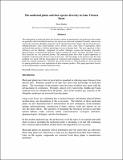The medicinal plants and their species diversity in Lake Victoria Basin
Author
Date
2004Type
Articleviews
downloads
Metadata
Show full item recordxmlui.dri2xhtml.METS-1.0.item-citation
The medicinal plants and their species diversity in Lake Victoria Basin Shyam Manohar Moi University, Environmental Biological Sciences Division, School of Environmental Studies, P.O. Box 3900, Eldoret – KENYA.
Abstract/
The management of medicinal plants has become a matter of international concern because these plants are generally wild in distribution and very few species are cultivated or planted. Presently, almost every Aayurvedic and many allopathic medicines can be obtained from lower plants; and also from the roots, underground parts, stem, aerial branches, leaves, flowers, fruits, seeds, barks of angiosperms. These medicinal plants produce a definite physiological action on human body. The most important of these substances are the alkaloids; compounds of carbon, hydrogen, oxygen and nitrogen; glucosides, pharmacologists to manufacture medicines, utilize essential oils, resins, mucilage, and gums. Some of these materials are very powerful poisons. The medicinal plants have been of great importance to mankind in relieving many diseases from ancient time. The knowledge of the primitive men has been modified very much with the advancement of civilization and technology to harvest these medicinal plants for commercial purposes. Therefore, this natural resource is really declining at a faster rate than its natural growth due to over exploitation of their economic products. This paper particularly focuses on the medicinal plants and their medicinal values.

